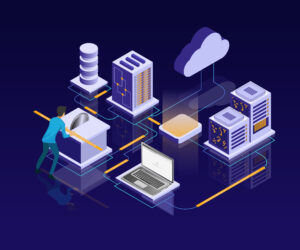Chances are you’ve welcomed some new little buddies into your home recently – you know, Amazon Alexa, Google Home, Wi-Fi-enabled appliances, and the like. While these Internet of Things devices promise convenience, they also open up your life to new risks. Alexa might hear more than you intend her to, and your new fridge could get hacked, leaking personal details you’d rather keep private. In this article, we’ll explore ways to keep your data secure so you can keep enjoying the perks of a connected home without the privacy pitfalls. We’ll look at encryption, strong passwords, data minimization, and more tips to help you keep your smart home from getting too nosy. Read on to take control of your privacy in the age of IoT!
The Internet of Things and Privacy Concerns

These days, smart devices are everywhere – from voice assistants and smart speakers to connected thermostats and doorbells. While IoT offers a lot of cool features, it also means that many of these gadgets are collecting data about you and your home. Should this worry you? In many cases, yes.
Data Collection
Many IoT devices track things like your location, routines, shopping habits, and more. This data is often collected by the companies that make the devices and shared with third parties for advertising. Some devices even have cameras and microphones that can capture audio and video from inside your home.
Hacking Dangers
Because many smart devices lack strong security, they are vulnerable to hackers. Hackers can gain access to your Wi-Fi network and IoT devices, allowing them to spy on you or even take control of the devices. In the worst cases, hackers have launched large-scale attacks using thousands of compromised IoT devices.
Lack of Transparency
It’s not always clear what data is being collected by smart devices and how it’s being used. Many companies don’t explicitly disclose in their privacy policies that they’re collecting personal details and sharing data with other companies. And once your data has been collected, it can be difficult to get companies to delete it.
While the convenience of smart homes is alluring, it’s important to go in with your eyes open. Take steps like enabling strong passwords on your Wi-Fi network and IoT devices, reading privacy policies carefully, and limiting access to personal spaces like bedrooms and bathrooms when possible. The future may be smart, but that doesn’t mean you have to sacrifice your privacy.
How IoT Devices Collect Your Data
These days, IoT devices are everywhere in your home – smart speakers, security cameras, thermostats, you name it. While they make our lives more convenient, they also gather tons of data about your daily activities, habits, and preferences.
- Always On and Always Listening. Many IoT devices have built-in microphones that are constantly listening for voice commands. Smart speakers like the Amazon Echo or Google Home record snippets of audio and send them to company servers. Security cameras with audio surveillance do the same. These devices are listening even when you don’t activate them, and the data they collect can reveal a lot about you and your routines.
- Connected and Communicating. IoT devices are connected to your Wi-Fi network and the internet, so they can communicate with company servers and each other. Your smart thermostat knows the temperature in each room of your house, while your home security system monitors when doors open or close. All this data is transmitted from your devices to the companies that make them, often with little transparency into how it’s collected or used.
- Vulnerable to Hacks. Because IoT devices are internet-connected, the data they gather can be vulnerable to cyberattacks and hacking. In the past, massive IoT device botnets have been used to stage DDoS attacks, while hackers have accessed smart camera feeds and even held devices for ransom. With more and more sensitive data being collected, IoT privacy and security risks are significant concerns that companies and consumers must address.
- Overall, IoT devices offer a lot of useful benefits, but it’s important to go in with your eyes open. Be aware of what data your devices are gathering and how it’s being used. Take steps to minimize risks like using strong passwords, enabling encryption, and keeping software up to date. The more you know about how your IoT devices work, the more control you’ll have over your privacy in the connected world.
Real-World Examples of IoT Privacy Breaches
1. Smart Speakers
Have you ever wondered if your smart speaker is listening even when you’re not actively using it? Unfortunately, several cases of smart speakers recording and sharing private conversations have come to light. In 2019, a German magazine found that Amazon had retained voice recordings of a family and shared them with a third-party contractor for review. The family never consented to having those recordings shared or retained.
2. Smart Home Devices
Smart home devices like thermostats, lights, and doorbells may seem innocuous, but the data they gather can be vulnerable. In one alarming case, a casino used smart thermometers installed in guests rooms to monitor when they were likely sleeping or away in order to target higher-value guests. The guests did not consent to having their room usage data monitored and shared.
3. Fitness Trackers
Fitness trackers and health apps gather sensitive health data to provide insights into your activity and wellness. However, several cases have revealed how vulnerable that data can be. In 2019, a Finnish company left unsecured a database containing the personal details of thousands of people using pregnancy and ovulation trackers. The data included intimate details like sexual activity, menstruation, pregnancy, and abortion details.
The Internet of Things offers many useful services, but it also enables new threats to privacy that we have not had to grapple with before. As these real-world examples show, personal data gathered from IoT devices can be vulnerable to hacking, misuse, and unconsented sharing. Consumers should consider their privacy risks before adopting new smart devices and services. Companies producing and handling consumer IoT data need to prioritize privacy and security to regain and maintain users’ trust. Overall, privacy protections have not kept up with the rapid growth of the Internet of Things, but consumers and companies can work together to demand and implement better safeguards.
Best Practices for Protecting Your Privacy With IoT
When it comes to smart devices, it’s important to take steps to safeguard your data and privacy. Here are some best practices to keep in mind:
- Enable Two-Factor Authentication: Many IoT devices like smart speakers, security cameras, and smart locks offer two-factor authentication, which adds an extra layer of security to your account. Enable it whenever possible. Two-factor authentication requires not only your password but also a code sent to your phone or an authentication app. This makes it much harder for hackers to access your accounts and devices.
- Use Strong, Unique Passwords: Reusing the same password across sites and accounts is a major security risk. Make sure you use strong, unique passwords for your IoT devices that contain a mix of letters, numbers and symbols. Don’t reuse passwords from other accounts. If one of your accounts is compromised, it can then be used to access other accounts with the same password.
- Keep Software Up to Date : Like your laptop and smartphone, IoT devices require regular software and firmware updates to patch security vulnerabilities and bugs. Make sure your devices install the latest updates automatically whenever possible. Outdated software and firmware are a prime target for hackers looking to access devices.
- Review Privacy Policies : Before buying an IoT device, review its privacy policy to understand how your data and information may be collected and shared. Some companies share more data with third parties or allow more access than others. Look for devices from companies that collect and share as little personal data as possible and allow you to opt out of data sharing whenever possible.
Following these best practices will help reduce privacy and security risks from your connected smart devices. While IoT technology offers many useful benefits, it’s important to go in with your eyes open to how your data could potentially be accessed or misused if proper safeguards are not taken. Take control of your smart devices and be proactive about protecting your privacy.
Securing Your Smart Home: An IoT Privacy Checklist
To keep your smart home secure, there are a few steps you should take. Your connected devices are constantly monitoring you and your family, so protecting privacy is key.
Change default passwords
The first thing you should do is change the default passwords on all your smart devices. Many people never change them, leaving their systems open to hacking. Pick strong, unique passwords for each device and enable two-factor authentication if available.
Review data collection policies
Connected devices gather tons of data about how you live, move and behave in your own home. Carefully read the privacy policies for each of your smart devices to see what data they collect and how it’s used. Make sure you’re comfortable with the amount of data being gathered before bringing a new connected gadget into your home.
Disable features you don’t use
Many smart home devices have features that are turned on by default but that you may not actually use. For example, if you have a smart speaker but don’t use the voice assistant, turn that feature off. The less data your devices can collect, the better. Go through the settings on each of your connected gadgets and turn off anything you don’t need.
Consider smart home alternatives
If you have serious concerns about privacy and data security with smart home tech, you may want to consider “dumb” alternatives. Things like programmable thermostats, timers, and motion-sensing lights can give you some automation without the privacy risks. You’ll lose some high-tech capabilities but gain peace of mind.
Taking a few steps to lock down your smart home network and be more selective about how your IoT devices gather data can help give you the benefits of an automated, connected home without sacrificing your privacy. Your smart tech may be watching, but you’re in control of what it sees and shares.
Key Takeaways
So in this connected world, your data is out there whether you like it or not. But you’re not powerless. Take control of your privacy. Audit your devices and accounts. Use strong passwords and two-factor authentication. Limit app permissions. Encrypt your network traffic. Speak up about privacy rights. And think before you click, share or buy. With a little savvy, you can harness technology’s potential while protecting what’s yours. This is your life and it’s worth fighting for. The future may feel unpredictable, but it’s still yours to shape.
More Stories
Madison Technologies’ AI-Powered Rail Safety Innovation Earns Top Global Cisco Award
As you navigate the complex landscape of rail safety innovation, you'll find that Madison Technologies has emerged as a true...
Why Google Cloud’s Mandatory MFA is a Game-Changer for Secure Access
In an era where cyber threats are evolving at an alarming rate, Google Cloud is taking a bold step to...
Telstra’s IoT State of the Nation 2024: Shaping a Data-Driven, Climate-Ready Australia Through IoT Innovation
As we await Telstra’s IoT State of the Nation 2024 event, let’s observe Australia’s digital transformation. This pivotal gathering on November 14 in Sydney promises to unveil groundbreaking insights into the Internet of Things (IoT) landscape.
China’s Leap into AI Warfare: Researchers Adapt Meta’s LLaMA for Military Applications
China has made a significant leap forward in the world of AI. Chinese researchers have adapted Meta’s open-source LLaMA model for military applications, marking a pivotal moment in the global AI race. This development showcases China’s growing technological prowess.
OpenAI’s Latest Search Function Transforms AI Interaction
The introduction of an advanced search function for ChatGPT marks a significant leap forward in AI capabilities. This new feature allows real-time information access from the web, ensuring that your queries are met with up-to-date and accurate responses.
Terra Drone Takes Flight with IPO Plans to Transform the Future of Air Mobility
Terra Drone Corporation emerges as a pivotal player in redefining the future of drone technology. Debuting in the Tokyo Stock Exchange’s Growth Market, Terra Drone soared to new heights in Advanced Air Mobility (AAM).



